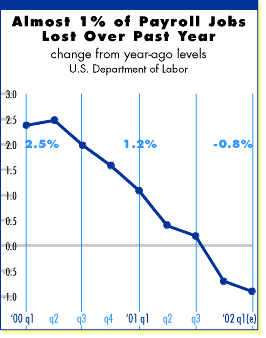
Technology-based areas most affected by recession

AIA Chief Economist
Economic indicators of late provide solid evidence that the recent recession in the U.S. economy has ended. Overall, this short period of economic weakness will end up as one of the mildest recessions in recent times. Still, many workers and many businesses felt a substantial softening in business conditions. The national unemployment rate rose from 3.9% in October 2000 to 5.8% in December 2001. Over 1.1 million payroll positions on net—just less than 1% of the total—were lost between March 2001 when the recession began and February 2002 when it apparently ended.
 Job
losses unbalanced
Job
losses unbalanced
Rolling recessions affecting certain regions were commonplace in the 1970s
and 1980s. Remember the downturns in energy dependent industries in the
mid-1970s, in the manufacturing sector in the early 1980s, in the oil-producing
regions in the mid-1980s, and financial services and credit-sensitive
areas in the early 1990s. During the 10 years of economic growth that
followed, from 1991 to 2001, all areas of the country alike benefited
from healthy economies and extended stability.
However, regional economic fluctuations have reappeared and are likely to be with us for awhile. It is evident that not all areas of the country fared equally during this recession. The sectors of the economy hardest hit during (and just prior to) this recession are manufacturing, technology, and Internet-based businesses. In the months following the September 11 terrorist attacks, travel and hospitality businesses also suffered tremendously. They now are recovering.
Areas with heavy concentrations of these industries have seen the greatest losses to their economic performance. Conversely, areas that have performed well recently are those less dependent on these sectors. Of the states that that have seen modestly healthy job growth over the past year, most are in the agriculture-based and resource-dependent Plains and Mountain regions: Wyoming, North Dakota, Oklahoma, Nebraska, Nevada, and Idaho. States that have experienced the greatest job losses proportionally tend to have technology-dependent economies: Washington, Colorado, New York, and Massachusetts.
Overall, almost three-quarters of states lost payroll jobs between February of 2001 and February of 2002. For many, the job losses were reasonably modest. However, 18 states lost over 1% of total payroll employment, and two states—Washington and Georgia—lost over 2% of payroll positions. Most of the states losing jobs are major industrial areas with higher wages and higher incomes, so the impact on the overall economy will be greater than job losses indicate.

Unemployment levels
high in several California metropolitan areas
The national unemployment rate stood at 5.5% in February, relatively low
by historical standards but still a substantial increase from the 4.2%
rate of a year earlier. Currently, the regions with the highest unemployment
rates are the Pacific and Middle Atlantic. Both of these regions have
seen an increase in the unemployment rate in excess of the national average
over the past year. However, the greatest increase in unemployment has
been in the Mountain states, where the unemployment rate has increased
almost two percentage points over the past year.

Overall, the California economy has fared reasonably well during this recession. Its share of payroll losses over the past year, -0.2%, has been well below the national average. Given the diversity of the California economy, while overall losses have been modest, some areas have been hit very hard. Of the 322 metropolitan areas in the U.S., the top five in terms of their current unemployment rate are in California. The technology slowdown has hurt the Bay area economy, particularly Silicon Valley businesses south of the Bay area.
San Jose, the center the technology economy, has seen the sharpest growth in unemployment over the past year of any metropolitan area in the country. Unemployment has risen 5.8 percentage points to 7.5%. Other technology-dependent areas also have seen dramatic increases in the unemployment rate, including Portland-Vancouver (up 4.2 percentage points), and Dallas and Colorado Springs (both up 3.6 percentage points). These areas will begin to respond as the broader economy continues to recover, and businesses resume their technology investments.
Metropolitan
Areas with Highest Unemployment
Concentrated in California
February 2002 metro unemployment
rates
Source: U.S. Department of Labor

Copyright 2002 The American Institute of Architects. All rights reserved.
![]()
|
This Just In Economists Agree to Add Special Program to Convention Baker and Murray to present construction outlook on May 11—click for details. |
|